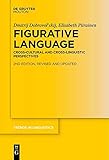Figurative Language : Cross-Cultural and Cross-Linguistic Perspectives / Dmitrij Dobrovol'skij, Elisabeth Piirainen.
Material type: TextSeries: Trends in Linguistics. Studies and Monographs [TiLSM] ; 350Publisher: Berlin ; Boston : De Gruyter Mouton, [2021]Copyright date: ©2022Edition: 2nd, rev.and updated edDescription: 1 online resource (XVI, 487 p.)Content type:
TextSeries: Trends in Linguistics. Studies and Monographs [TiLSM] ; 350Publisher: Berlin ; Boston : De Gruyter Mouton, [2021]Copyright date: ©2022Edition: 2nd, rev.and updated edDescription: 1 online resource (XVI, 487 p.)Content type: - 9783110616910
- 9783110702606
- 9783110702538
- 401.9 22/eng/20230216
- online - DeGruyter
- Issued also in print.
| Item type | Current library | Call number | URL | Status | Notes | Barcode | |
|---|---|---|---|---|---|---|---|
 eBook
eBook
|
Biblioteca "Angelicum" Pont. Univ. S.Tommaso d'Aquino Nuvola online | online - DeGruyter (Browse shelf(Opens below)) | Online access | Not for loan (Accesso limitato) | Accesso per gli utenti autorizzati / Access for authorized users | (dgr)9783110702538 |
Frontmatter -- Preface -- Acknowledgements -- Contents -- 1 General issues -- 2 Conventional figurative language and phraseology -- 3 On the cross-linguistic equivalence of idioms -- 4 Motivation of conventional figurative units -- 5 “False friends” and paronyms -- 6 The Cognitive Theory of Metaphor -- 7 Idioms of Fear: A cognitive approach -- 8 Cognitive modelling of figurative semantics -- 9 Specific frames: The concept House in language and culture -- 10 Culture and figurative language -- 11 Cultural symbolism in figurative language -- 12 Numeral words and number symbols in culture and language: Case studies -- 13 Animal metaphors and animal symbols: Case studies -- 14 Conclusions -- References -- Abbreviations -- Subject index
restricted access online access with authorization star
http://purl.org/coar/access_right/c_16ec
The book develops a Theory of the Figurative Lexicon. Units of the figurative lexicon (conventional figurative units, CFUs for short) differ from all other elements of the language in two points: Firstly, they are conventionalized. That is, they are elements of the mental lexicon – in contrast to freely created figurative expressions. Secondly, they consist of two conceptual levels: they can be interpreted at the level of their literal reading and at the level of their figurative meaning – which both can be activated simultaneously.New insights into the Theory of Figurative Lexicon relate, on the one hand, to the metaphor theory. Over time, it became increasingly clear that the Conceptual Metaphor Theory in the sense of Lakoff can only partly explain the conventional figurativeness. On the other hand, it became clear that “intertextuality” plays a far greater role in the CFUs of Western cultures than previously assumed.The book’s main target audience will be linguists, researchers in phraseology, paremiology and metaphor, and cultural studies. The data and explanations of the idioms will provide a welcome textbook in courses on linguistics, culture history, phraseology research and phraseodidactics.
Issued also in print.
Mode of access: Internet via World Wide Web.
In English.
Description based on online resource; title from PDF title page (publisher's Web site, viewed 25. Jun 2024)


